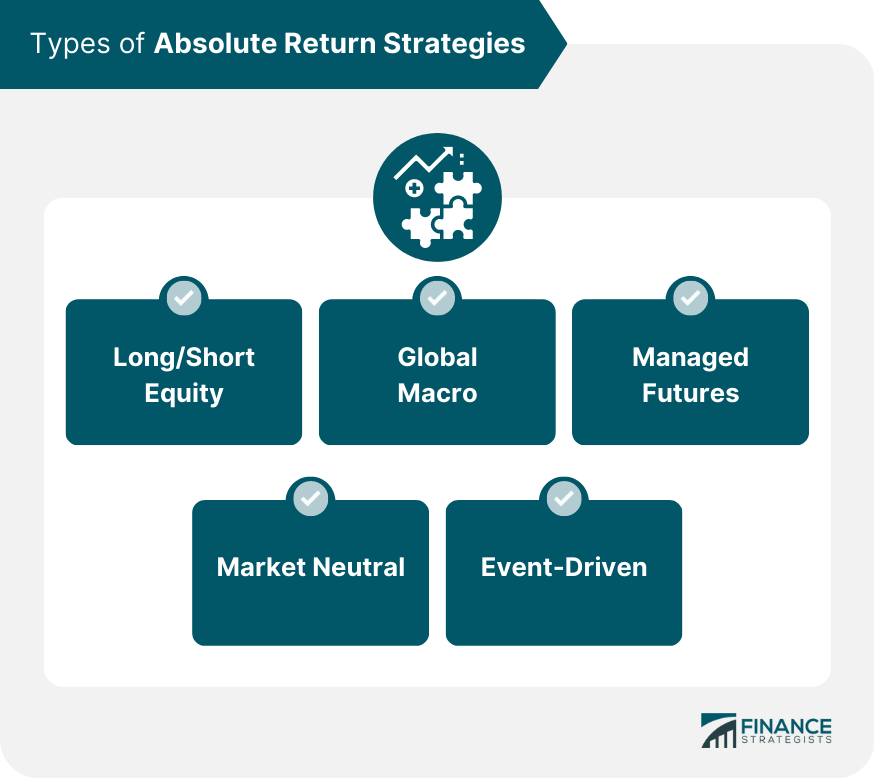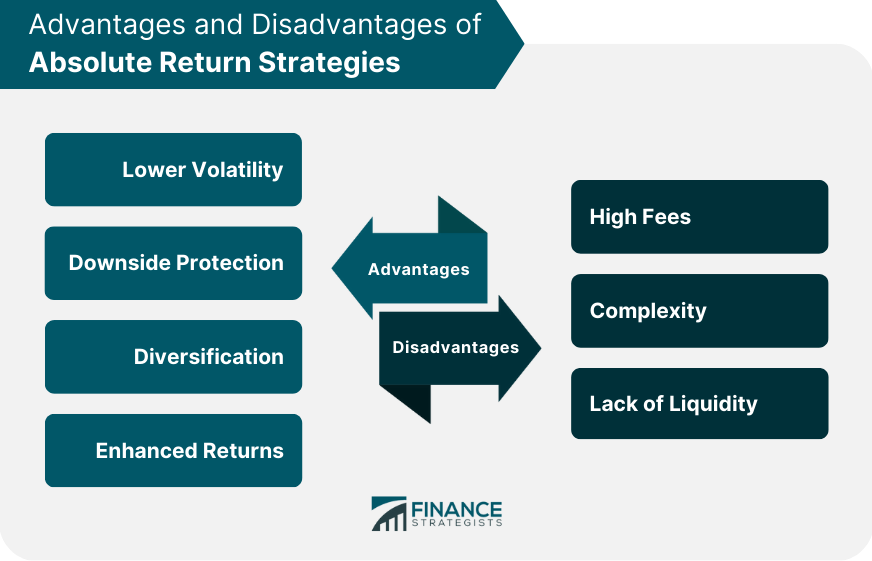Absolute return strategies are investment strategies that aim to achieve positive returns regardless of the direction of the financial markets. The goal is to generate a positive return in any market condition, whether it is rising, falling, or flat. Absolute return strategies aim to outperform traditional benchmarks, such as the S&P 500, by focusing on generating positive returns on a consistent basis. In today's volatile financial markets, investors are increasingly turning to absolute return strategies to provide stability to their portfolios. These strategies offer a potential solution to the unpredictability and volatility of traditional investments such as stocks and bonds. Absolute return strategies provide a more stable and consistent return, regardless of market conditions, which can help investors achieve their financial goals more effectively. Absolute return strategies come in several types, each with its own unique approach to generating positive returns. Long/short equity strategies involve buying stocks that the investor expects to rise in value (long positions) and shorting stocks that the investor expects to decline in value (short positions). This approach aims to generate positive returns regardless of the direction of the overall stock market. Global macro strategies aim to take advantage of global economic and political events by investing in a range of asset classes, such as stocks, bonds, currencies, and commodities. These strategies focus on identifying trends and market inefficiencies to generate positive returns. Market neutral strategies involve buying and shorting securities simultaneously to create a market-neutral portfolio. This approach aims to generate positive returns regardless of the direction of the overall market, by betting on individual securities rather than the overall market. Managed futures strategies involve investing in futures contracts across a range of asset classes, such as commodities, currencies, and bonds. These strategies aim to take advantage of trends and market inefficiencies to generate positive returns. Event-driven strategies involve investing in companies that are experiencing significant corporate events, such as mergers and acquisitions, or bankruptcies. These strategies aim to take advantage of market inefficiencies created by these events to generate positive returns. Absolute return strategies share several key characteristics that make them attractive to investors. Absolute return strategies focus on managing risk by seeking to minimize losses and generate positive returns in all market conditions. This approach helps investors achieve their financial goals while minimizing the risk of significant losses. Absolute return strategies have a low correlation with traditional investments, such as stocks and bonds. This characteristic makes them an excellent tool for diversifying portfolios and reducing overall portfolio risk. Absolute return strategies aim to generate positive returns consistently, regardless of market conditions. This focus on generating positive returns can help investors achieve their financial goals more effectively. Absolute return strategies offer flexibility in terms of asset class, investment style, and market exposure. This flexibility allows investors to adapt their investment strategy to changing market conditions, which can help them generate positive returns in all market environments. Absolute return strategies offer several advantages to investors seeking to achieve consistent positive returns. Absolute return strategies are designed to generate consistent positive returns with lower volatility than traditional investments, such as stocks and bonds. This characteristic makes them an attractive tool for reducing overall portfolio risk. Absolute return strategies offer downside protection by seeking to minimize losses in all market conditions. This approach can help investors avoid significant losses during market downturns and minimize the impact of market volatility on their portfolios. Absolute return strategies have a low correlation with traditional investments, which makes them an excellent tool for diversifying portfolios. By adding absolute return strategies to their portfolios, investors can reduce their overall portfolio risk and increase their potential for positive returns. Absolute return strategies aim to generate positive returns regardless of market conditions, which can help investors achieve their financial goals more effectively. These strategies have the potential to generate higher returns than traditional investments, such as stocks and bonds, which can provide investors with a significant advantage in achieving their financial objectives. Despite the advantages of absolute return strategies, they also have several disadvantages that investors should be aware of. Absolute return strategies tend to have higher fees than traditional investments, such as stocks and bonds. These higher fees can eat into the overall returns generated by the strategy and reduce the net return to the investor. Absolute return strategies can be complex and difficult to understand, particularly for investors who are new to the strategy. This complexity can make it difficult for investors to evaluate the performance of the strategy and determine whether it is meeting their investment objectives. Some absolute return strategies, such as hedge funds, may have restrictions on investor withdrawals, which can limit investor liquidity. This lack of liquidity can make it difficult for investors to access their capital when they need it, which can be problematic during times of financial stress. Several examples of absolute return strategies exist in the market today, including: Bridgewater Associates' Pure Alpha Fund is a global macro strategy that seeks to generate positive returns by investing across a range of asset classes, including stocks, bonds, currencies, and commodities. The fund uses a systematic, quantitative approach to investing, which aims to identify market inefficiencies and trends to generate positive returns. AQR Capital Management's Absolute Return Fund is a market-neutral strategy that seeks to generate positive returns by buying and shorting individual securities simultaneously. The fund uses a quantitative approach to investing, which aims to identify mispricings in individual securities to generate positive returns. Millennium Management's Millennium USA LP is a long/short equity strategy that seeks to generate positive returns by buying stocks that are expected to rise in value and shorting stocks that are expected to decline in value. The fund uses a fundamental approach to investing, which focuses on analyzing individual companies and industries to identify mispricings in individual securities. Absolute return strategies are becoming increasingly popular among investors seeking to achieve consistent positive returns in all market conditions. These strategies offer several advantages, including lower volatility, downside protection, diversification, and enhanced returns. However, they also have several disadvantages, such as high fees, complexity, and lack of liquidity. By understanding the different types, key characteristics, advantages, disadvantages, and examples of absolute return strategies, investors can make informed investment decisions that align with their investment objectives and risk tolerance.Definition of Absolute Return Strategies
Types of Absolute Return Strategies
Long/Short Equity
Global Macro
Market Neutral
Managed Futures
Event-Driven

Key Characteristics of Absolute Return Strategies
Risk Management
Low Correlation With Traditional Investments
Focus on Generating Positive Returns
Flexibility
Advantages of Absolute Return Strategies
Lower Volatility
Downside Protection
Diversification
Enhanced Returns
Disadvantages of Absolute Return Strategies
High Fees
Complexity
Lack of Liquidity

Examples of Absolute Return Strategies
Bridgewater Associates' Pure Alpha Fund
AQR Capital Management's Absolute Return Fund
Millennium Management's Millennium USA LP
Conclusion
Absolute Return Strategies FAQs
Absolute return strategies aim to generate positive returns regardless of market conditions by using various investment techniques.
Examples include long/short equity, event-driven, and global macro strategies. Each strategy aims to generate returns independent of market trends.
Absolute return strategies offer diversification benefits, lower volatility, and the potential for positive returns in all market conditions.
One potential drawback is that some absolute return strategies may have higher fees due to the specialized knowledge and active management required.
Investors who want to reduce their exposure to market volatility or seek uncorrelated sources of returns should consider adding absolute return strategies to their portfolio.
True Tamplin is a published author, public speaker, CEO of UpDigital, and founder of Finance Strategists.
True is a Certified Educator in Personal Finance (CEPF®), author of The Handy Financial Ratios Guide, a member of the Society for Advancing Business Editing and Writing, contributes to his financial education site, Finance Strategists, and has spoken to various financial communities such as the CFA Institute, as well as university students like his Alma mater, Biola University, where he received a bachelor of science in business and data analytics.
To learn more about True, visit his personal website or view his author profiles on Amazon, Nasdaq and Forbes.











